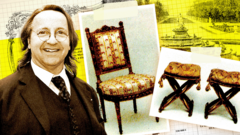**Two renowned craftsmen face trial over fraudulent sales, revealing a complex web of deceit that reached high-profile buyers, including the Palace of Versailles.**
**The Versailles Furniture Scam: A Tale of Deception and Loss**

**The Versailles Furniture Scam: A Tale of Deception and Loss**
**A scandal involving forged antiques disrupts the French art world while raising concerns about authenticity checks.**
The early 2010s saw a remarkable incident unfold in the world of antique furniture, where two lavish chairs claimed to be from the Palace of Versailles surfaced in the French market. Allegedly crafted for the last queen of France, Marie Antoinette, these chairs bore the renowned stamp of Nicolas-Quinibert Foliot, a prominent 18th-century carpenter. In a notable announcement in 2013, the French government designated these pieces as "national treasures" following Versailles' expressed interest in their purchase. However, priced beyond the palace's budget, the chairs were eventually sold to Qatari Prince Mohammed bin Hamad Al Thani for an astonishing €2 million (£1.67 million).
This sale was part of a much larger assemblage of 18th-century royal furniture, which had gained traction in the antique market over recent years. Included in this collection were additional chairs purportedly used by Marie Antoinette, items owned by Madame du Barry, King Louis XVI's sister, and other royal families. While Versailles acquired many pieces for its museum display, the story turned dark when, in 2016, it was discovered that these items, including the prominent chairs, were forgeries.
This significant fraud case saw the involvement of French antiques expert Georges "Bill" Pallot and award-winning cabinetmaker Bruno Desnoues, who were both charged with fraud and money laundering after years of investigation. Their trial set for March in a Pontoise court signaled a broader scrutiny of the antiques industry, with Pallot and Desnoues admitting their misdeeds, while some accusations against their gallery, Galerie Kraemer, are still contested.
Pallot, a recognized authority on 18th-century chairs, and Desnoues had initially embarked on their counterfeit journey in jest, attempting to replicate an antique chair they were restoring for Madame du Barry. Buoyed by their success, they began to produce an array of fraudulent pieces, sourcing low-cost wood and aging it to mimic the appearance of genuine antiques. They even added markings and labels from authentic furniture workers to reinforce their deception.
Profits from this intricate scheme, estimated at over €3 million, were funneled into foreign bank accounts, sparking further investigations when the extravagant lifestyle of a woman tied to their network raised red flags with authorities. This inquiry led to the shocking discovery of Pallot and Desnoues' extensive operations.
The case has amplified calls for stronger regulation in the art market, especially regarding authenticity verification standards. Despite some original defendants having their charges dropped, the trial against Pallot, Desnoues, and Galerie Kraemer highlights the need for better safeguards against ill-intentioned practices within the prestigious world of antiques.
As the case continues to unravel, it serves as a cautionary reminder about the importance of vigilance in evaluating historical artifacts—especially those steeped in royal lineage and fame. The ongoing trial reflects not just a betrayal of trust among experts but also raises queries about the legacy of the treasures of institutions like Versailles. The verdict will likely shape the future of antique dealings in France, prompting a reevaluation of how authenticity is ascertained and celebrated.
This sale was part of a much larger assemblage of 18th-century royal furniture, which had gained traction in the antique market over recent years. Included in this collection were additional chairs purportedly used by Marie Antoinette, items owned by Madame du Barry, King Louis XVI's sister, and other royal families. While Versailles acquired many pieces for its museum display, the story turned dark when, in 2016, it was discovered that these items, including the prominent chairs, were forgeries.
This significant fraud case saw the involvement of French antiques expert Georges "Bill" Pallot and award-winning cabinetmaker Bruno Desnoues, who were both charged with fraud and money laundering after years of investigation. Their trial set for March in a Pontoise court signaled a broader scrutiny of the antiques industry, with Pallot and Desnoues admitting their misdeeds, while some accusations against their gallery, Galerie Kraemer, are still contested.
Pallot, a recognized authority on 18th-century chairs, and Desnoues had initially embarked on their counterfeit journey in jest, attempting to replicate an antique chair they were restoring for Madame du Barry. Buoyed by their success, they began to produce an array of fraudulent pieces, sourcing low-cost wood and aging it to mimic the appearance of genuine antiques. They even added markings and labels from authentic furniture workers to reinforce their deception.
Profits from this intricate scheme, estimated at over €3 million, were funneled into foreign bank accounts, sparking further investigations when the extravagant lifestyle of a woman tied to their network raised red flags with authorities. This inquiry led to the shocking discovery of Pallot and Desnoues' extensive operations.
The case has amplified calls for stronger regulation in the art market, especially regarding authenticity verification standards. Despite some original defendants having their charges dropped, the trial against Pallot, Desnoues, and Galerie Kraemer highlights the need for better safeguards against ill-intentioned practices within the prestigious world of antiques.
As the case continues to unravel, it serves as a cautionary reminder about the importance of vigilance in evaluating historical artifacts—especially those steeped in royal lineage and fame. The ongoing trial reflects not just a betrayal of trust among experts but also raises queries about the legacy of the treasures of institutions like Versailles. The verdict will likely shape the future of antique dealings in France, prompting a reevaluation of how authenticity is ascertained and celebrated.
















